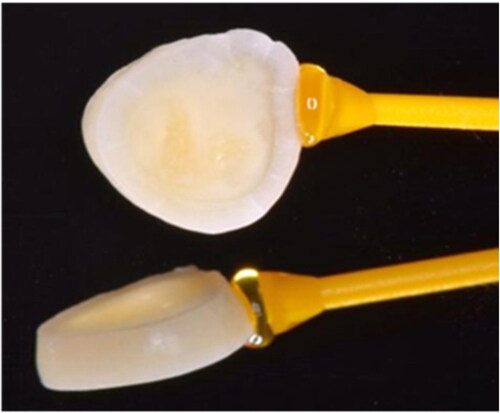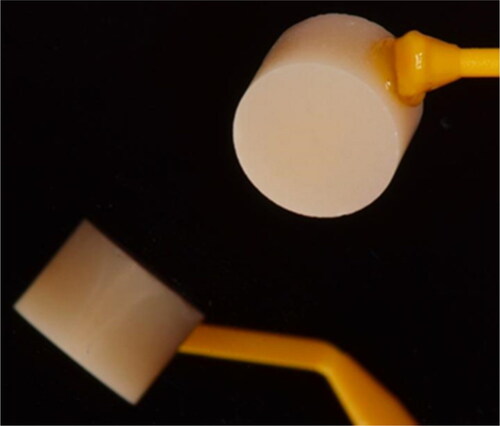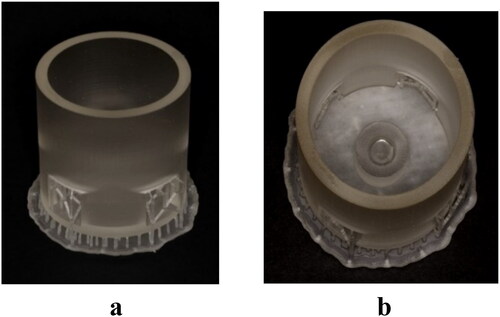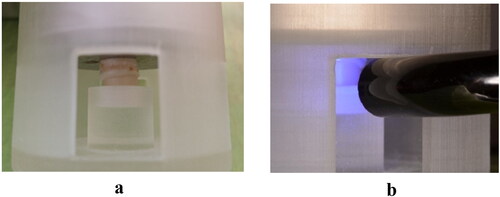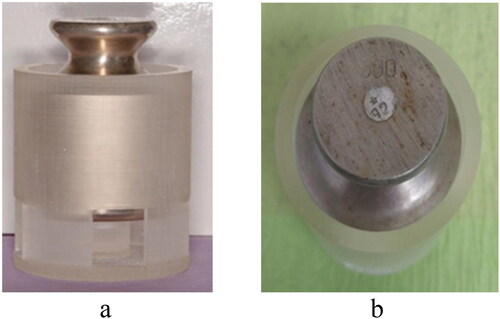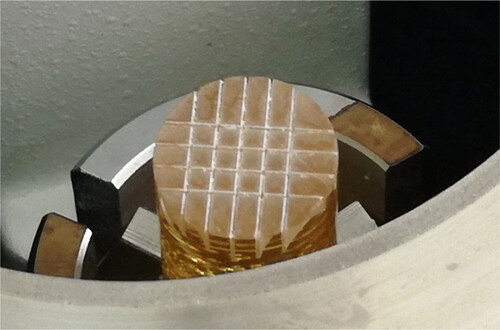 ?Mathematical formulae have been encoded as MathML and are displayed in this HTML version using MathJax in order to improve their display. Uncheck the box to turn MathJax off. This feature requires Javascript. Click on a formula to zoom.
?Mathematical formulae have been encoded as MathML and are displayed in this HTML version using MathJax in order to improve their display. Uncheck the box to turn MathJax off. This feature requires Javascript. Click on a formula to zoom.Abstract
Zirconia ceramic is a modern material used for different types of prosthetic constructions, characterized by high mechanical resistance and aesthetics. The main difficulties in treatment are related to ensuring a stable and durable bond between the ceramic and dentin. This study examined the bonding strength of ZirCAD Multi (3rd generation) and ZirCAD Prime (5th generation) ceramics when using different types of cements before and after sandblasting the surface of zirconia with Al2O3. For this purpose, an experimental setup was created by 3D printing, in which sintered ceramic cylinders were cemented to dentin slices of natural teeth with different types of cements. From the formed ceramic-dentin constructions, test specimens were cut with a microtome and tested for tensile strength. The results showed an increase in the strength of the bond after sandblasting from 1.1 MPa to 2.4 MPa for ZirCAD Multi and from 1.6 MPa to 3.3 MPa for ZirCAD Prime. Zirconia ceramic ZirCAD Prime (5th generation) showed higher adhesion resistance, with the strongest bond being with the Speed Cem Plus and Panavia V5 cements. With ZirCAD Multi, the maximum tensile strength was achieved with the Rely X Luting Plus and Speed Cem Plus cements. Optimal strength and bond resistance were registered between the new fifth-generation zirconia ceramic and composite cements with MDP (10-methacryloyloxydecyl dihydrogen phosphate) primers.
Introduction
Zirconia ceramic is a modern material widely used in dental medicine [Citation1]. Its main advantages are high bending strength and fracture resistance, which provide greater strength compared to other ceramic materials [Citation2]. The mechanical resistance and the possibility of achieving good esthetics allow for the production of various types of prosthetic constructions [Citation3]. The main problems in the treatment with zirconia ceramic are related to providing stable and durable bonding with cement [Citation4,Citation5]. The problems are due to the structure of zirconia, which unlike classical ceramics, does not allow effective etching of the surface [Citation6]. Better results are observed when etched with fluoride compounds (ammonium hydrogen difluoride, potassium hydrogen difluoride) and subsequent silanization [Citation7]. Most authors agree that silanization enhances the bond between zirconia ceramic and composite cements [Citation8,Citation9]. According to others, silanization does not improve the adhesion to zirconia [Citation10]. Studies show that pre-sandblasting treatment of the zirconia surface with Al2O3 significantly improves the bond strength [Citation11]. According to some data, air abrasion with Al2O3 increases the roughness of the zirconia ceramic regardless of the size of the particles used [Citation12]. Other authors find optimal results with particles of 50 μm in diameter [Citation9]. There are also opinions that mechanical treatment of the zirconia surface has little influence on the strength of the bond [Citation13].
Studies show that sandblasting with silica dioxide (CoJet, SiJet) improves cement adhesion [Citation14]. Additional application of primers with different chemical compositions improves the bond durability with zirconia ceramics [Citation15]. Laboratory studies show the best results with primers containing 10-methacryloyloxydecyl dihydrogen phosphate (MDP) [Citation16]. It is established that even the application of MDP primer after sandblasting provides optimal bond strength [Citation17,Citation18]. Measurements of bond strength between zirconia ceramics and composite cements containing MDP primer show resistance and stability of the bond [Citation19,Citation20]. Similar results are observed when using MDP primer after treating the zirconia surface with a silica-zirconia suspension [Citation21]. The application of MDP-based silane and bonding agents improves bond strength, as well [Citation22]. These advantages provide a basis for some authors to recommend the use of composite cements containing MDP over glass ionomer cements [Citation23]. Others identify resin-modified glass ionomer cement (RMGIC) as a suitable alternative to composite cements [Citation18].
Data from some studies indicate that composite cements with zirconium primers containing tetra-n-propoxy zirconium (TPZr) provide greater bonding strength compared to MDP [Citation24]. Positive results are also observed when combining MDP/silane primers after sandblasting with silicon dioxide [Citation25,Citation26]. The additional inclusion of bisphenol A glycol dimethacrylate (BisGMA) does not improve the qualities of phosphate-containing primers but reduces the effectiveness of silane ones [Citation27].
According to the literature, regardless of the chemical composition of primers, they enhance the adhesion of cement [Citation28,Citation29]. An important condition for their effectiveness is the prior cleaning of the surface with a chemical agent and uniform application [Citation30].
The emergence of new types of ceramics requires additional research on their adhesion to different cementing agents, which is crucial for the success of the treatment.
The aim of this study was to measure and compare the bond strength of the zirconia ceramics IPSe.maxZirCAD Multi (3rd generation) and IPSe.maxZirCAD Prime (5th generation) with different types of cements.
Materials and methods
Ethics statement
Ethical approval was provided by the Commission on Scientific Research Ethics at the Medical University of Sofia during the assessment of the project.
Experimental design
Seventy human teeth extracted due to periodontal reasons with intact crowns were used. For the purposes of the study, two types of zirconia ceramics and 6 types of cements were used. From the coronal part of the teeth, 118 dentin discs with a thickness of 2.5 mm were successfully cut with a microtome (). For their cementation to the ceramics by CAD/CAM milling, 96 (48 for each ceramic) ceramic cylinders (experimental bodies) with a diameter of 9 mm and a height of 8 mm were made ().
The study included two types of zirconia ceramics – IPS e.max ZirCAD Multi (3rd generation) and IPS e.max ZirCAD Prime (5th generation). IPS e.max ZirCAD Multi contains two classes of zirconium dioxide – 5Y-TZP and 4Y-TZP, providing a high strength level of 850 Mpa. The production of IPS e.max ZirCAD Prime uses a new, unique Gradient Technology (GT) production technique, combining 3Y-TZP (1200 Mpa) and 5Y-TZP (650 Mpa) zirconium dioxide, providing a strength of 1850 Mpa. For the purposes of the study, a cylinder with a height of 62 mm and a diameter of 40 mm was made by 3D printing with Form 2 SLA (Formlabs Inc., USA) from a liquid photopolymer, on which there was a smaller cylinder with a diameter of 9 mm and a height of 5 mm for fixing the experimental body (). The smaller height of this cylinder compared to the experimental body provided space for the subsequent application of cement and placement of the dentin disc (). To enable light polymerization in the outer cylinder, 4 windows were made ().
The diameter of the large cylinder corresponded to the outer diameter of a standard weight of 500 g according to the Bulgarian State Standard (BSS), which ensured stable fixation of the dentin disc to the zirconia surface after cementation ().
The study evaluated the effect of mechanical surface treatment on ceramic bonding by dividing the test samples into two groups. Half of the samples were treated with 50 µm Al2O3 under a pressure of 2 Bar, a distance of 10 mm, and an angle of 90°, while the other half was left untreated as a control. Four composite cements, Speed Cem Plus (Ivoclar Vivadent), Thera Cem (BISCO), Panavia V5 (Kuraray), and Variolink Esthetic DC (Ivoclar Vivadent), as well as two resin-modified glass ionomer cements, RelyX Luting Plus (3 M) and Fuji Plus (GC), were used for cementation of the dentin discs. The zirconia surface was prepared according to the specific requirements of each cement, and the test body was placed in the cylinder and covered with cement, on which the dentin disc and 500-gram weight were placed. Light polymerization was carried out through the four side windows according to the cement type.
The ceramic-dentin constructs were embedded in epoxy resin in a cylindrical matrix and allowed to cure for 72 h (). Using a Leica SP1600 microtome (Leica Biosystems, Germany), test specimens (beams) measuring 2 × 2×20 mm were cut, similar to the dimensions of the dentin discs ().
Figure 6. The packaged ceramic-dentin construction (1 – packaging material/epoxy resin; 2 – dentin block; 3 – cementing agent; 4 – zirconia body; 5 – packaging material/epoxy resin).
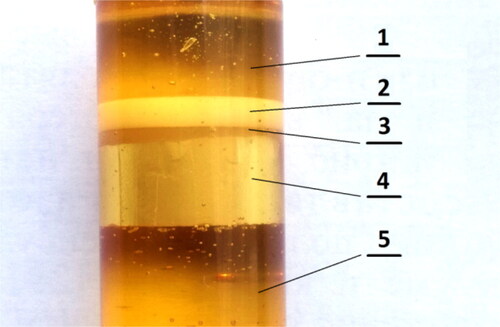
The tensile strength micro-test of the undamaged test bodies was conducted using a physico-mechanical testing machine ‘LMT-100’ (LAM Technologies, Italy).
Data analysis
The data analysis was performed using IBM SPSS Statistics 25.0 (IBM SPSS Statistics for Windows, SPSS Inc., Chicago, IL, USA). Graphical analysis was used for the visualisation of the obtained results. Nonparametric Shapiro-Wilk test was used to check the distribution of quantitative variables of normality. One-way analysis of variance (ANOVA) was used for comparison of arithmetic mean values of more than two independent samples. Student’s t-test was used for testing hypotheses of difference between two independent samples. The non-parametric Mann–Whitney test was used for testing hypotheses of difference between two independent samples.
Results
The comparative analysis of the tensile bond strength of the investigated cements applied to the sandblasted ceramic IPS e.max ZirCAD Multi and IPS e.max ZirCAD Prime zirconia ceramics showed significant difference in 4 of the examined types of cement – Fuji Plus, RelyX Luting Plus, Panavia V5 and Speed Cem Plus (). Significantly higher mean values of IPS e.max ZirCAD Multi were observed for RelyX Luting Plus, while for IPS e.max ZirCAD Prime for the other three types of cement.
Table 1. Comparative tensile bond strength analysis of studied cement types applied to sandblasted ceramic IPS e.max ZirCAD Prime and IPS e.max ZirCAD Multi.
The tensile bond strength of the sandblasted zirconia surface showed that for half of the tested cements (Speed Cem Plus, Panavia V5, and Fuji Plus), the tensile bond strength was significantly higher with ZirCAD Prime compared to ZirCAD Multi. The results were comparable for the cements Variolink Esthetic DC and Thera Cem. Only the combination of ZirCAD Multi and RelyX Luting Plus cement showed stronger adhesion compared to ZirCAD Prime.
The results of the mTBS test on sandblasted ceramics showed different tensile strengths, ranging from 1.6–3.3 MPa for ZirCAD Prime to 1.1–2.4 MPa for ZirCAD Multi. The strongest bond was measured between Speed Cem Plus and ZirCAD Prime – 3.3 MPa. The bond strength with cement in ZirCAD Multi was much lower – 2.3 MPa, but the values were close to the maximum achieved with RelyX Luting Plus. Panavia V5 showed good adhesion resistance to ZirCAD Prime – 2.8 MPa, which was significantly higher than the measured 1.7 MPa in ZirCAD Multi. The examination of the bond strength of Variolink Esthetic DC showed similar results in both ceramics – 2.4 MPa in ZirCAD Prime and 2.2 MPa in ZirCAD Multi. Weaker bond strength and approximately equal values were recorded in Thera Cem – 2 MPa for ZirCAD Prime and 1.9 MPa for ZirCAD Multi. The only cement that showed better adhesion to ZirCAD Multi was RelyX Luting Plus – 2.4 MPa compared to 1.9 MPa in ZirCAD Prime. The weakest bond strength was measured in Fuji Plus – 1.1 MPa for ZirCAD Multi and 1.6 MPa for ZirCAD Prime.
The comparative analysis of the tensile bond strength of the studied types of cement, applied to non-sandblasted IPS e.max ZirCAD Multi and IPS e.max ZirCAD Prime ceramics showed significant difference in 4 of the studied cements – Fuji Plus, TheraCem, Panavia V5 and Speed Cem Plus (). Significantly higher mean values were observed in IPS e.max ZirCAD Prime.
Table 2. Comparative tensile bond strength analysis of studied cement types applied to non-sandblasted ceramic IPS e.max ZirCAD Prime and IPS e.max ZirCAD Multi.
The untreated surface of zirconia ceramic showed lower adhesive strength within the range of 0.2–0.7 MPa for ZirCAD Multi and 0.5–1.2 MPa for ZirCAD Prime. The comparative study among different cements showed similar results and ratios to those achieved with sandblasted ceramics, but with 2–3 times lower values. The strongest bond was observed between ZirCAD Prime and Speed Cem Plus and Panavia V5 cements, with values of 1.2 MPa and 0.9 MPa, respectively. For ZirCAD Multi, the values were twice as low: 0.6 MPa and 0.4 MPa. Regarding Variolink Esthetic DC, Thera Cem and RelyX Luting Plus, the bond strength for both ceramics was in the range of 0.4–0.8 MPa. The weakest adhesion was observed with Fuji Plus: 0.2 MPa for ZirCAD Multi and 0.5 MPa for ZirCAD Prime. The most resistant and the only stronger bond for ZirCAD Multi compared to ZirCAD Prime was with RelyX Luting Plus, 0.7 MPa.
Discussion
The analysis of the results showed a significant increase in bond strength after sandblasting the ceramic surfaces with all types of cements. The prevailing opinion that this type of mechanical treatment improves bond strength was confirmed [Citation11,Citation12]. The ceramic surface was treated with Al2O3 particles with a diameter of 50 μm, which according to some authors is the optimal size for creating roughness on zirconia [Citation9]. Inokoshi et al. confirm the effect of ceramic surface sandblasting on the bond strength [Citation13]. In our study, greater effectiveness was achieved with ZirCAD Multi ceramic, where the bond strength increased from 2.4 to 4.5 times with different cements. With ZirCAD Prime, the increase was from 1.7 to 2.3 times, but the strongest bond in the study was recorded at 3.3 MPa with Speed Cem Plus cement. The strongest adhesion bond was recorded before sandblasting with the same type of ceramic and cement. With ZirCAD Multi and Speed Cem Plus, a weaker tensile strength of 2.3 MPa was recorded, but the values were higher compared to most other cements. This supported the data from many other studies demonstrating the advantages of MDP primer cements [Citation16–18]. The significantly better results achieved compared to other composite cements demonstrated the effectiveness of the Monobond Plus primer, containing both 10-MDP and silane. The data indicating that this combination provides bond strength and resistance were confirmed [Citation25,Citation26]. The obtained results were comparable with the findings of other authors after additional application of 10-MDP based silane and a bonding agent mix [Citation22]. The use of a gel for cleaning the zirconia surface allowed for improved adhesion, as reported by other authors [Citation30].
The bond stability with ZirCAD Prime was reported even when using Panavia V5 cement containing MDP/silane primer, but with added BisGMA (5–15%). The measured bond strength of 2.8 MPa after sandblasting was weaker than the values reported in other studies (6.0 ± 3.0 MPa) [Citation10]. The results differed significantly with ZirCAD Multi, where the bond strength was only 1.7 MPa. The lower values compared to Speed Cem Plus showed that the inclusion of BisGMA does not actually improve the qualities of phosphate primers, but reduces the effectiveness of silane primers [Citation27].
The investigation of the bond strength between the two ceramics and Variolink Esthetic DC showed similar results – 2.4 MPa with ZirCAD Prime and 2.2 MPa with ZirCAD Multi. The inclusion of BisGMA (10–25%) in the cementation kit did not provide as stable a bond as with Speed Cem Plus and Panavia V5 cements using MDP primers. Although this was the only cementing system with dentin etching with 37% phosphoric acid, it did not increase the bond strength for both ceramics. The measured values were comparable to results from other studies, which reported 5.0 ± 3.6 MPa [Citation28]. The use of a primer with a higher BisGMA content compared to Panavia V5 showed that this does not increase but decreases the bond strength, as observed in other studies [Citation27].
The composite cement Thera Cem exhibited weaker bond strength. Despite its primer composition including 10-MDP and BisGMA (1–5%), the measured values with ZirCAD Prime were 2 MPa, and with ZirCAD Multi were 1.9 MPa. The achieved results showed equal effectiveness of the cement for both ceramics, although the values were lower than in other studies that reported 2.94 ± 0.42 MPa [Citation19]. The study showed that the inclusion of BisGMA in the primer composition and its percentage content have an influence on the bond strength. Optimal results are obtained with 5 to 15% BisGMA in the MDP/silane primers (Panavia V5). Increasing the percentage content in silane primers reduces bond strength (Variolink Esthetic DC). Adding BisGMA to the phosphate primer of Thera Cem does not increase bond strength, as shown in other studies [Citation27]. The strongest and most stable bond was established with the primer Monobond Plus, containing 10-MDP and silane without BisGMA (Speed Cem Plus).
A comparative study of the adhesive strength of the two resin-modified glass ionomer cements, RelyX Luting Plus and Fuji Plus, showed interesting results. The measured bond strength of 1.9 MPa between ZirCAD Prime and RelyX Luting Plus was lower than that of composite cements. In this case, the use of glass ionomer cement without etching, priming, or bonding did not provide a stable bond, which confirmed the superiority of composite cements with primers [Citation19,Citation20]. Interestingly, good results were obtained with ZirCAD Multi, where the microtensile bond strength test recorded a maximum bond strength of 2.4 MPa. The measured values were more than twice as large as those with Fuji Plus, higher than composite cements, and equal to those achieved between ZirCAD Prime and Variolink Esthetic DC. The results for both ceramics were comparable to other studies that reported 1.5 ± 1.0 MPa using RelyX with Single Bond [Citation28]. The stable adhesion between ZirCAD Multi and RelyX Luting Plus supports the opinion that RMGICs are a suitable alternative to composite cements [Citation18].
The weakest and least reliable bond was recorded with Fuji Plus, where the measured values for ZirCAD Prime were 1.6 MPa, and for ZirCAD Multi 1.1 MPa. The additional use of a conditioner for processing the zirconia surface did not affect the strength of the bond. The tensile strength of this glass-ionomer cement was significantly lower compared to RelyX Luting Plus and composite cements. The weaker performance of Fuji Plus in the study confirmed the view that composite cements provide a stronger and more durable bond compared to glass-ionomer cements [Citation23].
Conclusions
The present study showed that sandblasting the ZirCAD Prime and ZirCAD Multi zirconia ceramics increased the strength of the bond with composite and glass-ionomer cements several times. Depending on the type of cement used, the adhesion resistance of ZirCAD Multi varied from 1.1 MPa to 2.4 MPa, and for ZirCAD Prime from 1.6 MPa to 3.3 MPa. ZirCAD Prime (5th generation) zirconia ceramics showed higher adhesion resistance compared to ZirCAD Multi (3rd generation), with the strongest bond being with Speed Cem Plus and Panavia V5 cements. Optimal bond strength for ZirCAD Multi was achieved with Rely X Luting Plus and Speed Cem Plus cements.
Authors’contributions
IG, ER and TU conceptualized the study. IG, ER and TU collected the data. IG analyzed the data. IG wrote the paper. All authors read and approved the final manuscript.
Disclosure statement
No potential competing interest was reported by the authors.
Data availability statement
The data that support the findings of this study are available from the corresponding author upon reasonable request.
Additional information
Funding
References
- Giordano IR. Ceramics overview. Br Dent J. 2022;232(9):1–7.
- Machry RV, Dapieve KS, Cadore-Rodrigues AC, et al. Mechanical characterization of a multi-layered zirconia: flexural strength, hardness, and fracture toughness of the different layers. J Mech Behav Biomed Mater. 2022;135:105455. doi: 10.1016/j.jmbbm.2022.105455.
- Bacchi A, Cesar PF. Advances in ceramics for dental applications. Dent Clin North Am. 2022;66(4):591–602. doi: 10.1016/j.cden.2022.05.007.
- Comino-Garayoa R, Peláez J, Tobar C, et al. Adhesion to zirconia: a systematic review of surface pretreatments and resin cements. Materials (Basel). 2021;14(11):2751. doi: 10.3390/ma14112751.
- Russo DS, Cinelli F, Sarti C, et al. Adhesion to zirconia: a systematic review of current conditioning methods and bonding materials. Dent J (Basel). 2019;7(3):74. doi: 10.3390/dj7030074.
- Raszewski Z, Brząkalski D, Derpeński L, et al. Aspects and principles of material connections in restorative dentistry - A comprehensive review. Materials (Basel). 2022;15(20):7131. doi: 10.3390/ma15207131.
- Ruyter EI, Vajeeston N, Knarvang T, et al. A novel etching technique for surface treatment of zirconia ceramics to improve adhesion of resin-based luting cements. Acta Biomater Odontol Scand. 2017;3(1):36–46. doi: 10.1080/23337931.2017.1309658.
- Chen C, Li S, Ou ME, et al. The effect of nano-silica surface infiltration on bond strength of a phosphate-monomer-containing composite cement to zirconia. J Adhes Dent. 2023;25(1):79–86.
- Prasad HA, Pasha N, Hilal M, et al. To evaluate effect of airborne particle abrasion using different abrasives particles and compare two commercial available zirconia on flexural strength on heat treatment. Int J Biomed Sci. 2017;13(2):93–112.
- de Figueiredo VMG, Silva AM, Massi M, et al. Effect of the nanofilm-coated zirconia ceramic on resin cement bond strength. J Dent Res Dent Clin Dent Prospects. 2022;16(3):170–178. doi: 10.34172/joddd.2022.029.
- Abdulla MA, Hasan RH. Shear bond strength of two repair systems to zirconia ceramic by different surface treatments. J Lasers Med Sci. 2022;13:e31. doi: 10.34172/jlms.2022.31.
- Tostes BO, Guimarães RB, Noronha-Filho JD, et al. Characterization of conventional and high-translucency Y-TZP dental ceramics submitted to air abrasion. Braz Dent J. 2017;28(1):97–104. doi: 10.1590/0103-6440201701035.
- Inokoshi M, Shimizu H, Nozaki K, et al. Crystallographic and morphological analysis of sandblasted highly translucent dental zirconia. Dent Mater. 2018;34(3):508–518. doi: 10.1016/j.dental.2017.12.008.
- Peçanha MM, Amaral M, Baroudi K, et al. Improving the bonding stability between resin cements and zirconia-based ceramic using different surface treatments. Int J Prosthodont. 2022;35(4):414–419. doi: 10.11607/ijp.6797.
- Ju GY, Lim BS, Moon W, et al. Primer-treated ceramic bracket increases shear bond strength on dental zirconia surface. Materials (Basel). 2020;13(18):4106. doi: 10.3390/ma13184106.
- Guilardi LF, Pereira G, Giordani JC, et al. Cement choice and the fatigue performance of monolithic zirconia restorations. Oper Dent. 2022;47(4):461–472. doi: 10.2341/20-143-L.
- Chatterjee N, Ghosh A. Current scenario on adhesion to zirconia; surface pretreatments and resin cements: a systematic review. J Indian Prosthodont Soc. 2022;22(1):13–20. doi: 10.4103/jips.jips_478_21.
- Yang L, Xie H, Meng H, et al. Effects of luting cements and surface conditioning on composite bonding performance to zirconia. J Adhes Dent. 2018;20(6):549–558.
- Saleh NE, Guven MC, Yildirim G, et al. Effect of different surface treatments and ceramic primers on shear bond strength of self-adhesive resin cement to zirconia ceramic. Niger J Clin Pract. 2019;22(3):335–341.
- Salem RST, Ozkurt-Kayahan Z, Kazazoglu E. In vitro evaluation of shear bond strength of three primer/resin cement systems to monolithic zirconia. Int J Prosthodont. 2019;32(6):519–525. doi: 10.11607/ijp.6258.
- Su Z, Li M, Zhang L, et al. A novel porous silica-zirconia coating for improving bond performance of dental zirconia. J Zhejiang Univ Sci B. 2021;22(3):214–222. doi: 10.1631/jzus.B2000448.
- Özdemir H, Yanikoğlu N, Sağsöz N. Effect of MDP-based silane and different surface conditioner methods on bonding of resin cements to zirconium framework. J Prosthodont. 2019;28(1):79–84. doi: 10.1111/jopr.12650.
- De Angelis F, D’Arcangelo C, Buonvivere M, et al. Shear bond strength of glass ionomer and resin-based cements to different types of zirconia. J Esthet Restor Dent. 2020;32(8):806–814. doi: 10.1111/jerd.12638.
- Murakami T, Takemoto S, Nishiyama N, et al. Zirconia surface modification by a novel zirconia bonding system and its adhesion mechanism. Dent Mater. 2017;33(12):1371–1380. doi: 10.1016/j.dental.2017.09.001.
- Passia N, Mitsias M, Lehmann F, et al. Bond strength of a new generation of universal bonding systems to zirconia ceramic. J Mech Behav Biomed Mater. 2016;62:268–274. doi: 10.1016/j.jmbbm.2016.04.045.
- Bielen V, Inokoshi M, Munck JD, et al. Bonding effectiveness to differently sandblasted dental zirconia. J Adhes Dent. 2015;17(3):235–242.
- Chen L, Shen H, Suh BI. Effect of incorporating BisGMA resin on the bonding properties of silane and zirconia primers. J Prosthet Dent. 2013;110(5):402–407. doi: 10.1016/j.prosdent.2013.04.005.
- Piemjai M, Nakabayashi N. Direct tensile strength and characteristics of dentin restored with all-ceramic, resin-composite, and cast metal prostheses cemented with resin adhesives. Biomed Res Int. 2015;2015:656948. doi: 10.1155/2015/656948.
- Shokry M, Al-Zordk W, Ghazy M. Retention strength of monolithic zirconia crowns cemented with different primer-cement systems. BMC Oral Health. 2022;22(1):187. doi: 10.1186/s12903-022-02223-0.
- Recen D, Yildirim B, Çeliksöz Ö. The effects of applying a novel cleaner on the bonding strength of zirconia surfaces. Proc Inst Mech Eng H. 2023;237(3):385–394. doi: 10.1177/09544119231151268.

